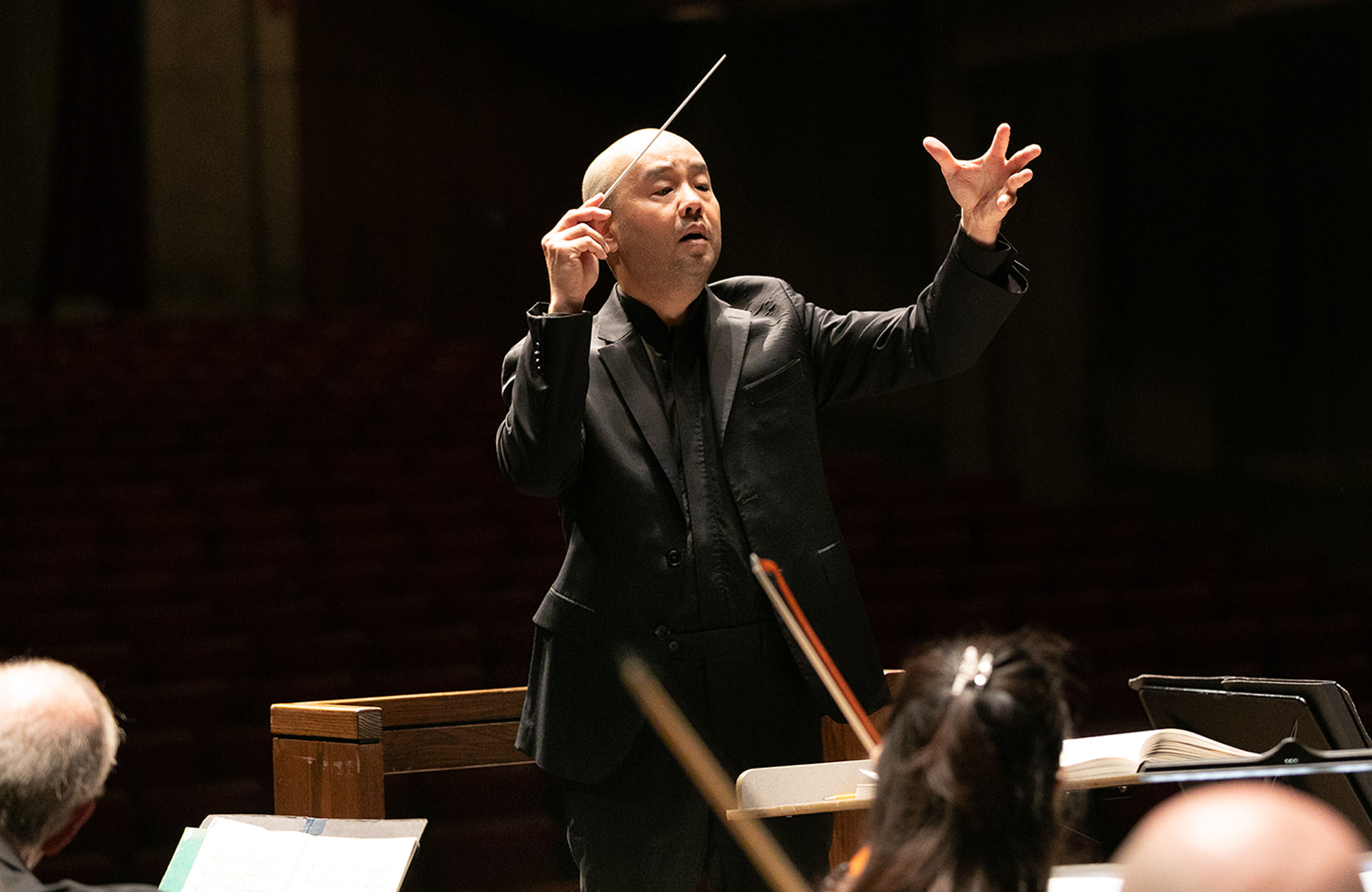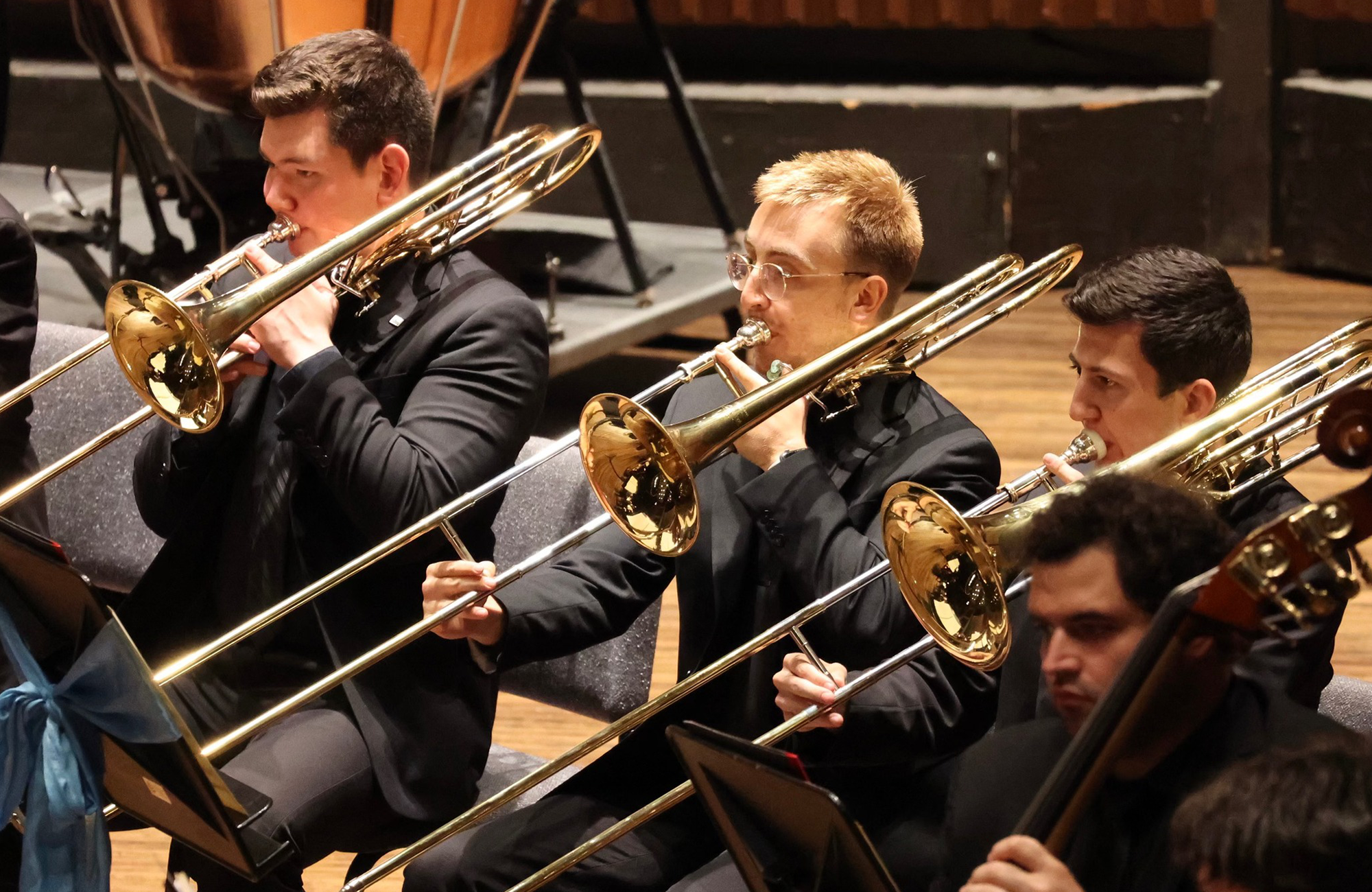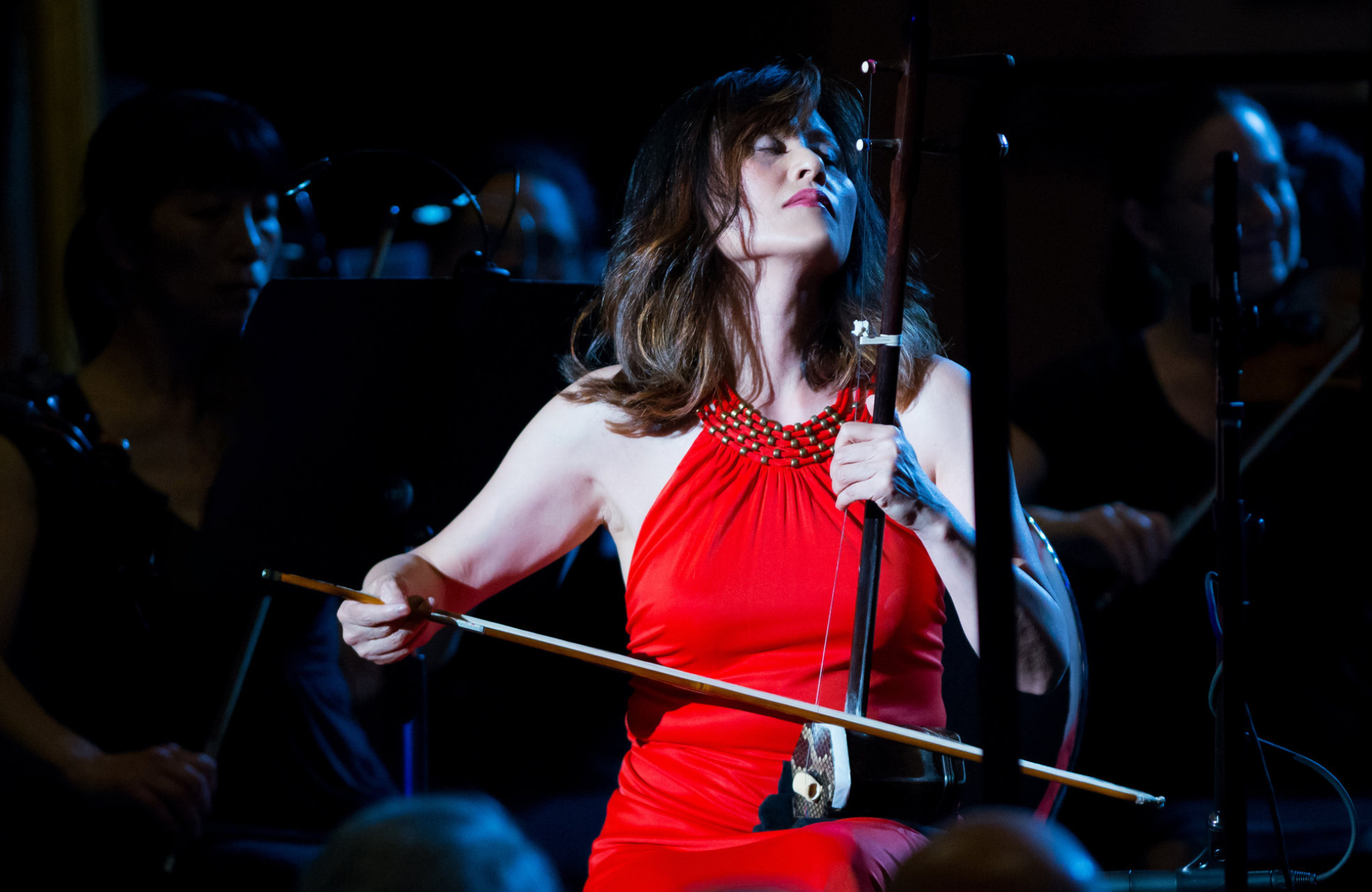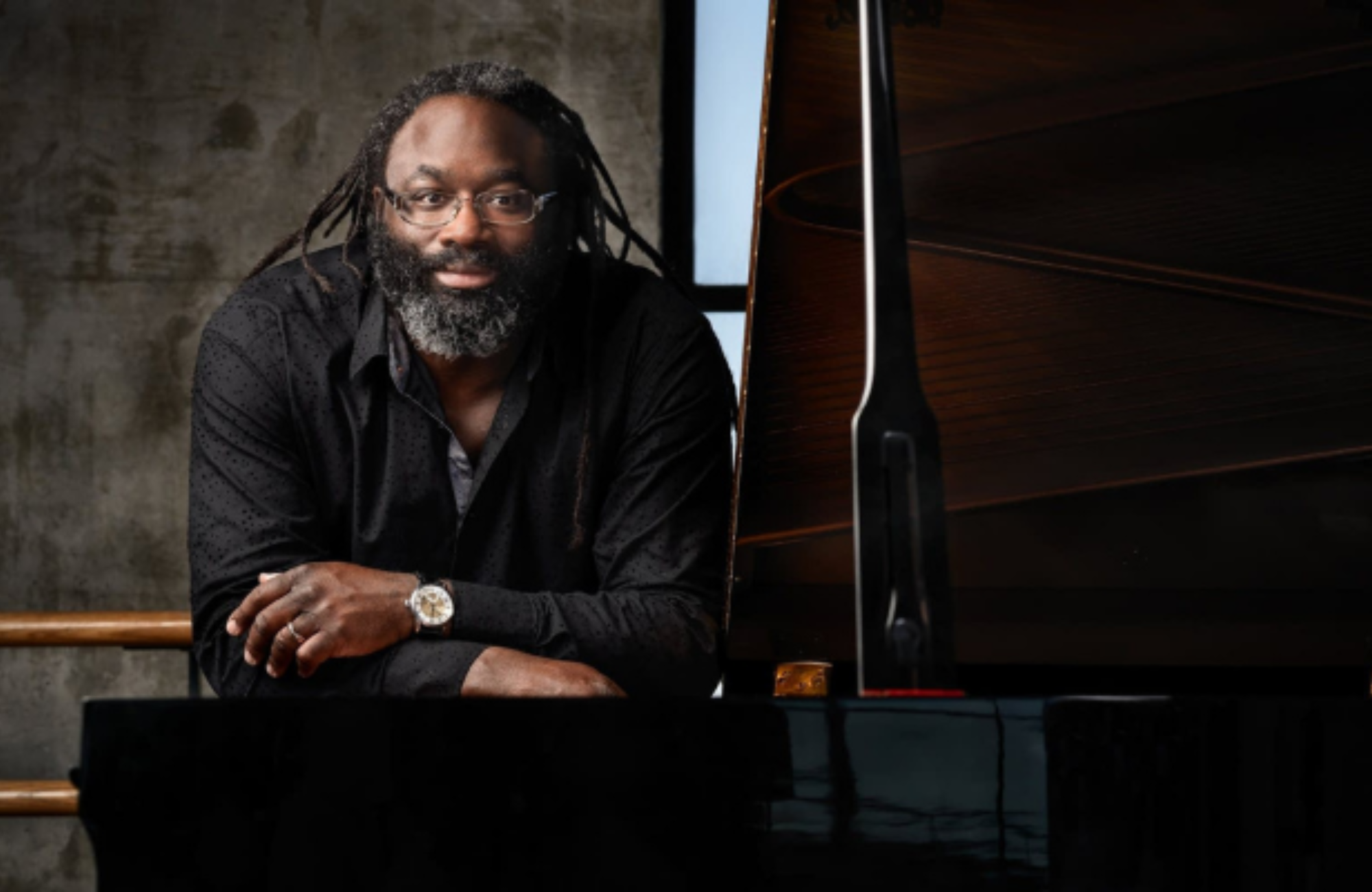Do you need be uplifted, inspired, and excited? Then join Music Director Lawrence Loh and the 300 musicians who will take the stage to perform the epic Symphony No. 2 by Gustav Mahler. It’s a concert you don’t want to miss. Symphoria performs with Syracuse University choirs: Oratorio Society, Crouse Chorale, Hendricks Chapel Choir, Setnor Sonority, and the Syracuse University Singers.
Thanks to our sponsors for this performance!
In memory of Evelyn Brenzel & Ann Marie Cronin

PROGRAM NOTES
At the heart of the last movement of his Second Symphony, Gustav Mahler (1860–1911) offers us one of the most memorable passages in 19th-century orchestral music. After a series of apocalyptic outbursts, the music dies down. Against a backdrop of distant fanfares, coming from different directions off-stage, a solo flute and a piccolo play what sound like bird calls, marked “delicately and fragrantly” in the score. The dynamic level so soft that, says principal flute Xue Su, it requires “extraordinary control” from the players. Not only does the sound evaporate; time seems to melt as well, since—despite ...
At the heart of the last movement of his Second Symphony, Gustav Mahler (1860–1911) offers us one of the most memorable passages in 19th-century orchestral music. After a series of apocalyptic outbursts, the music dies down. Against a backdrop of distant fanfares, coming from different directions off-stage, a solo flute and a piccolo play what sound like bird calls, marked “delicately and fragrantly” in the score. The dynamic level so soft that, says principal flute Xue Su, it requires “extraordinary control” from the players. Not only does the sound evaporate; time seems to melt as well, since—despite the clear 4/4 meter—the parts are written in what Xue calls a “mini-cadenza style with extra beats in the measure,” requiring flexibility without losing momentum.
Mahler might well have ended the symphony there, on a descent into silence, as he did his Ninth Symphony and Das Lied von der Erde. But the Second is a work of hope, not despair or even resignation; and this moment of emptiness is in fact a turning point. Almost inaudibly, we hear an unaccompanied chorus intoning a chorale, its words drawn from the German poet Friedrich Klopstock and expanded by Mahler himself. From there, the symphony moves to the most breathtaking symphonic conclusion in the 19th-century canon.
Indeed, the Second serves as a conclusion to the 19th-century canon. Mahler composed the work, often called the “Resurrection Symphony,” over a fairly long period, between 1888 and 1894; and whether or not he intended to produce a grand finale to the waning century, this work certainly serves that purpose, looking both backwards (the Beethoven Ninth is an obvious inspiration) and ahead. It’s massive in scale. At the time it was written, only a few symphonies could rival it for length; and it not only calls on a larger orchestra than any of its predecessors, but also requires an organ and chorus. More than any previous symphony, too, it takes advantage of the hall itself, employing a number of off-stage effects to create an unparalleled sense of space. No other symphony so fully envelops you in its own universe.
No other symphony is quite so eventful or so wide-ranging, either. The Second begins with a stinging tremolo and a series of slashing string gestures that leave you stunned, in the grip of a huge funeral rite. It’s a harrowing experience, building, at its center, to a wrenching series of increasingly loud and dissonant blows—a wall of sound that suddenly disappears, leaving in its wake a quiet tremolo on the violas before the symphony’s opening returns (technically, the recapitulation)—a moment of staggering surprise. Even if you don’t catch the references to the plainchant Dies Irae (Day of Wrath)—a melody already taken up by Berlioz and Liszt, and later by Rachmaninoff, among others—you’ll recognize this movement as evoking dread rather that grief. Only Mahler could have written something so harrowing. And only Mahler could have included, in the same movement, a second theme of such ethereal beauty—or could have followed it with a second movement in the form of a naïve folk dance (a Ländler). This Andante seems to inhabit a different world, a world that, in conductor Larry Loh’s words, is “innocent,” with the strong flavor of a lullaby.
The klezmer-inflected third movement brings us to yet another world. One of Mahler’s favorite sources of texts was Des Knaben Wunderhorn, a collection of German Folk Poetry published (and strongly edited, as was the custom) at beginning of 19th century. One poem he set recounts the story of St. Anthony of Padua, who, on finding that no one comes to church, goes to the river to preach to the appreciative fish. In the traditional version of this legend, the townspeople are so struck by this miracle that they change their ways. The disruptive folk-retelling, however, centers on the fish—who listen attentively, but remain unchanged. Mahler recycles the music of the song as his Scherzo—and even though he leaves out the text, you can sense its sardonic spirit in the music’s constant motion, its mockery, and its extreme sound effects, including glissandos on the strings, squawky woodwinds, and the use of the rute (twigs or dowels tied together and used to hit a drum). Larry describes the movement as a “sinuous and spine-tingling devil’s dance”; and it’s easy to understand why, 80 years later, Luciano Berio used it as the foundation for the third movement of his Sinfonia, a work that tries to come to terms with the madness and social disruption of the 1960s.
There’s another radical shift in direction as we move to the restrained fourth movement, what Larry calls a “quiet outcry.” Titled “Urlicht” (“Primal Light”), this movement also has its source in Des Knaben Wunderhorn. This time, however, the text, expressing simple faith in the face of humanity’s “greatest need,” is actually sung. Slow, sparsely orchestrated with magically shifting colors, and hovering at the quietest levels of sound (down to ppppp), it is surely one of the most poignant and beautiful movements in Mahler’s output. Even though it ends peacefully, however, its faith is not enough—at least not yet. Following a sustained chord on the strings that, according to Mahler’s directions, “vanishes completely,” the finale bursts through with without a break, uttering a towering cry of pain clearly modelled on the opening of the finale of the Beethoven Ninth. It’s only after a series of overwhelming struggles (including two gigantic percussion crescendos that, once heard, you’ll never forget) that we arrive at the flute/piccolo duet with which I began—and finally move toward the choral ending with its decisive resolution.
What does it all mean? At times, Mahler offered programs that charted out fairly detailed narratives for the score. More often, though, he rejected explanation, insisting that the work be presented entirely without the “false ideas” propagated by program notes: “Let the public have its own thoughts [without] preconceived ideas … instilled into it.” Larry has a similar perspective: “You can’t help but know the meaning of it—whatever that meaning is to you—while listening to it.” In any case, even on a blank-slate, first-time hearing, the trajectory is clear: Despite its circuitous route, this is a “darkness to light” symphony representing some kind of spiritual journey ending in illumination. As principal Second Violin Amy Christian puts it, “it’s music that cleanses your soul.” Larry finds himself transported, in a state of ecstasy—and you will, too.
I chose the word “spiritual” rather than “religious” intentionally. Obviously, the work is full of elements, both musical and textual, that have traditional religious resonance. But Mahler’s own beliefs are a subject of continued debate, and he doesn’t seem to have been an adherent of any particular religious doctrine. He was born Jewish, but was apparently not especially observant. And although he converted to Catholicism in 1897, he did so under pressure: In the anti-Semitic Vienna in which he lived, it was a pre-requisite before he could take on the leadership of the Court Opera. Throughout it all, he seems to have maintained a questioning stance shot through with ambiguities, ambiguities neatly encapsulated by his friend conductor Otto Klemperer: Mahler, he said, was “typically irreligious”—but “devout in the highest sense.”
In this context, it’s worth remembering that the “Resurrection” referred to in the finale is not the resurrection of Jesus. It’s the rebirth common to all Abrahamic—and many other—religions; moreover, it’s presented in a way that speaks to believers and non-believers alike. In other words, the Second is a humanist, rather than a specifically religious, work, and it joins a long list of choral masterpieces—like the Berlioz and Verdi Requiems, Vaughan Williams’s Dona Nobis Pacem, and especially the Beethoven Ninth—that unify their listeners in a way that transcends religious differences.
Is it any wonder that we chose this symphony to celebrate our tenth anniversary??
Peter J. Rabinowitz
Have any comments or questions? Please write to me at prabinowitz@ExperienceSymphoria.org
FEATURED ARTISTS

Laurel Semerdjian, an American mezzo-soprano of Armenian descent, has recently been hailed as “a dramatic and musical tour de force” (Pittsburgh Tribune) for her portrayal of Asakir in Pittsburgh Opera’s production of Mohammed Fairouz’s Sumeida’s Song. Her voice has been praised for its “guttural low notes” (...
Laurel Semerdjian, an American mezzo-soprano of Armenian descent, has recently been hailed as “a dramatic and musical tour de force” (Pittsburgh Tribune) for her portrayal of Asakir in Pittsburgh Opera’s production of Mohammed Fairouz’s Sumeida’s Song. Her voice has been praised for its “guttural low notes” (Pittsburgh Post Gazette) and “appealing weight, intensity and flexibility”.
In January 2020, Ms. Semerdjian returned to Pittsburgh Opera, singing the role of Bradamante in Handel’s Alcina and in the spring of 2020, Ms. Semerdjian made a company debut with Florentine Opera, singing the title role in Le Tragédie de Carmen, and was slated to return to Resonance Works to debut the role of Maddalena in Rigoletto and Symphony Tacoma for their Mozart Requiem (COVID19). During the 20-21 season, Ms. Semerdjian was slated to make a role debut with Young Victorian Theater Company as Ruth in The Pirates of Penzance, a return to Opera Southwest as Geneviève in Pelléas et Mélisande and was to join the Cape Symphony as the mezzo soloist in Beethoven’s Ninth Symphony (COVID19- postponed to 2022). In the spring of 2021, Ms. Semerdjian returned to Sarasota Opera in the role of Marianna in their production of Il Signor Bruschino and this summer, she will make her Missouri Symphony debut in their Opera Gala. In the fall of 2021, Ms. Semerdjian will be featured in a filmed project entitled Heroes which is co-produced by Resonance Works and Decameron Opera Coalition and will also join Symphony Tacoma as the mezzo soloist in Messiah and Mozart’s Requiem, Opera Southwest for their NYE gala, and will make her Madison Opera debut as Public Opinion in Orpheus in the Underworld.
During the 2018–2019 season, Ms. Semerdjian returned to Pittsburgh Opera as Suzuki in Madama Butterfly, sang the title role of Benazir Bhutto in a workshop of Mohammed Fairouz’s Bhutto with Pittsburgh Opera / Beth Morrison Projects, joined Symphony Tacoma as the alto soloist in Handel’s Messiah, rejoined Tacoma Opera for her debut in the title role of The Rape of Lucretia, and performed with Syracuse’s Symphoria as mezzo soloist in Haydn’s Mass in Time of War and Beethoven’s Symphony No. 9. In the summer of 2019, Ms. Semerdjian made company debuts as Flora in La traviata with Summer Garden Opera and Dorabella in Così fan tutte with Inland Northwest Opera. In the fall of 2019, Ms. Semerdjian returned to Pittsburgh Symphony in the Bruckner Te Deum and made her Opera Southwest debut in Bottesini’s rarely performed Alì Babà.
During the 2017–2018 season, Ms. Semerdjian returned to both Sarasota Opera, as Flora in La traviata, and Syracuse Opera, as Suzuki in Madama Butterfly. She made company debuts with St. Petersburg Opera (Florida) as Dritte Dame in Die Zauberflöte, with Pittsburgh’s Resonance Works as Ježibaba in Rusalka, and with Washington Concert Opera debut as guest soloist in their Opera’s Greatest Heroines gala concert. She also performed both Beethoven’s Symphony No. 9 and Haydn’s Mass in Time of War with Washington DC’s Cathedral Choral Society at the Washington National Cathedral.
Ms. Semerdjian made several significant role debuts throughout the 2016–2017 season. In her return to Bellevue City Opera she performed her first Dorabella in Così fan tutte, and in October 2016 she made her Syracuse Opera debut as Tisbe in La Cenerentola. In early 2017, Ms. Semerdjian returned to Sarasota Opera for her initial performances of the role of Suzuki in Madama Butterfly. She also made her Westmoreland Symphony Orchestra debut with her first performances of Beethoven’s Symphony No. 9.
Ms. Semerdjian also fulfilled two seasons as a Resident Artist with Pittsburgh Opera (2014–2016). Her responsibilities included performances of the roles of Mother Goose in The Rake’s Progress, Meg in Little Women, Gertrude Stein in Ricky Ian Gordon’s opera 27, Fenena in Nabucco, Emilia in Otello, Eduige in Rodelinda, Asakir in Sumeida’s Song, and covering the title role of Carmen. In the summer of 2015 she performed the role of Cherubino in Bellevue City Opera’s inaugural production of Le nozze di Figaro, and in the summer of 2014 she performed the role of Mercédès in Carmen as a Vocal Fellow at Music Academy of the West, under the guidance of legendary mezzo-soprano Marilyn Horne. As an Apprentice Artist with Sarasota Opera, she covered the role of Inez in the company’s 2014 production of Il trovatore.
During the 2012–2013 season Ms. Semerdjian was an Emerging Artist with the Dallas Opera. She performed the role of Veronica in Bizet’s Dr. Miracle in outreach performances in local schools as well as at the Winspear Opera House with the Dallas Opera Orchestra. She also covered the role of Sonia in the Dallas Opera’s production of Argento’s The Aspern Papers.
Ms. Semerdjian holds a Master of Music in Vocal Performance from the University of North Texas and a Bachelors of Music in Vocal Arts with a minor in Music Industry from the University of Southern California.
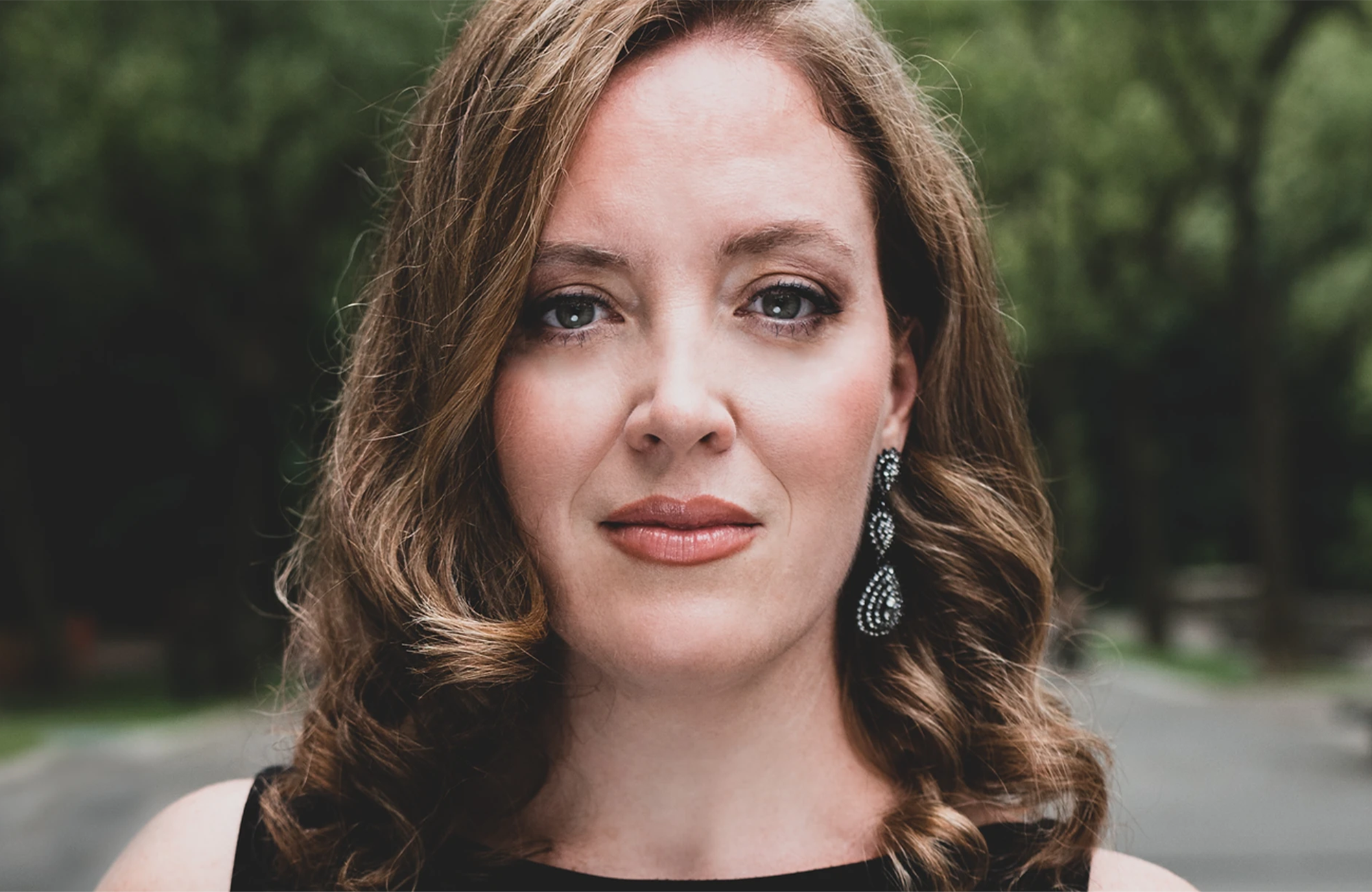
Katherine Whyte has delighted audiences and critics alike on opera and concert stages across her native Canada, the United States and Europe. Opera Today has praised her “keen artistic sensibility” while the San Francisco Classical Voice singled out “her glamorous, vibrato-rich voice”. Following her Metropolitan Opera debut in 2007 in ...
Katherine Whyte has delighted audiences and critics alike on opera and concert stages across her native Canada, the United States and Europe. Opera Today has praised her “keen artistic sensibility” while the San Francisco Classical Voice singled out “her glamorous, vibrato-rich voice”. Following her Metropolitan Opera debut in 2007 in Strauss’ Die Ägyptische Helena, she has returned to the company for productions of Iolanta, Rigoletto, Jenufa, The Gambler, The Enchanted Island, Two Boys, Parsifal, Don Giovanni, Così fan tutte, and Suor Angelica.
Recent and upcoming engagements for Ms. Whyte include her celebrated Countess Almaviva in Le nozze di Figaro with Intermountain Opera Bozeman; her debut with Syracuse’s Symphoria performing Poulenc’s Gloria; a return to New Choral Society as soprano soloist in Carmina Burana; a solo recital at Gordon College, her debut with Heartbeat Opera as Agathe in Der Freischütz; and Fiordiligi in Così fan tutte with Opera Grand Rapids.
The 2018-19 season for Ms. Whyte included Beethoven’s Ninth Symphony with the Louisiana Symphony, joining Opera Hong Kong as Donna Anna in Don Giovanni, Adina in L’elisir d’amore with Grand Junction Symphony Orchestra, and returning to The Metropolitan Opera for their production of Suor Angelica. The 2017-2018 season saw her back at The Metropolitan Opera for Parsifal as well as appearing in concert with the Mountain View International Festival of Song and the Orquesta Sinfonica Mineria for Beethoven’s Ninth Symphony. Additionally, she appeared with both Charlottesville Opera and the Norwalk Symphony as the Countess in Le nozze di Figaro. The 2016-2017 season included her return to The Metropolitan Opera for productions of Jenufa and Rigoletto, a debut with the Edmonton Symphony for Handel’s Messiah, Fauré’s Requiem with Manhattan Concert Productions at Carnegie Hall, and her debut with the Qingdao Symphony Orchestra in China. The 2015-2016 season saw her debut with the Dallas Opera as Pousette in Manon, a return to the Metropolitan Opera for their production of Rigoletto, the Countess in Le nozze di Figaro with Opera Saratoga, and concerts with the Kaohsiung Symphony Orchestra and the Orchestra of China’s National Opera at the Meet in Beijing Arts Festival.
Other notable operatic appearances include the title role of Iphigénie en Tauride and Iris in Semele with Canadian Opera Company, the Countess in Le nozze di Figaro with the Princeton Festival, her Vancouver Opera debut as Donna Anna in Don Giovanni, Gilda in Rigoletto with English National Opera, the Countess in Le nozze di Figaro with Virginia Opera and Opera Hamilton, Pamina in Die Zauberflöte with Michigan Opera Theatre, Euridice in Gluck’s Orfeo ed Euridice with Atlanta Opera, and Iphis in Handel’s Jephta with Opéra National de Bordeaux.
Ms. Whyte’s appearances on the concert stage include Beethoven’s Mass in C Major, Stravinsky’s Pulcinella, Mozart’s Requiem, and Handel’s Messiah with the Houston Symphony, Neilsen’s Symphony No. 3 with the San Francisco Symphony, Carmina burana and Beethoven’s Symphony No. 9 with the National Chorale, Beethoven’s Symphony No. 9 with the Arkansas Symphony Orchestra, Mozart’s Mass in C-minor with the Vancouver Symphony, Brahms’ Ein deutsches Requiem with the Orquesta Sinfónica Nacional de Costa Rica, Mendelssohn’s A Midsummer Night’s Dream with the Colorado Symphony, Handel’s Messiah with the National Symphony Orchestra, Beethoven’s Ninth Symphony with the Orquesta Sinfonica Nacional, Mozart’s Requiem with the Alabama Symphony Orchestra, and Handel’s Messiah with the New Choral Society. The winner of the 2007 Alice Tully Recital Competition, Ms. Whyte made her Carnegie Hall debut in Solo recital at Weill Hall in 2008.

Described as bringing an “artisan storyteller’s sensitivity… shaping passages with clarity and power via beautifully sculpted dynamics… revealing orchestral character not seen or heard before” (Arts Knoxville) Lawrence Loh enjoys a dynamic career as a conductor of orchestras all over the world.
After an extensive two ...
Described as bringing an “artisan storyteller’s sensitivity… shaping passages with clarity and power via beautifully sculpted dynamics… revealing orchestral character not seen or heard before” (Arts Knoxville) Lawrence Loh enjoys a dynamic career as a conductor of orchestras all over the world.
After an extensive two year search, Lawrence Loh was recently named Music Director of the Waco Symphony Orchestra beginning in the Spring of 2024. Since 2015, he has served as Music Director of The Syracuse Orchestra (formerly called Symphoria), the successor to the Syracuse Symphony Orchestra. “The connection between the organization and its audience is one of the qualities that’s come to define Syracuse’s symphony as it wraps up its 10th season, a milestone that might have seemed impossible at the beginning,” (Syracuse.com) The Syracuse Orchestra and Lawrence Loh show that it is possible to create a “new, more sustainable artistic institution from the ground up.”
Appointed Assistant Conductor of the Pittsburgh Symphony in 2005, Mr Loh was quickly promoted to Associate and Resident Conductor within the first three years of working with the PSO. Always a favorite among Pittsburgh audiences, Loh returns frequently to his adopted city to conduct the PSO in a variety of concerts. Mr. Loh previously served as Music Director of the West Virginia Symphony Orchestra, Music Director of the Northeastern Pennsylvania Philharmonic, Artistic Director and Principal Conductor of the Syracuse Opera, Music Director of the Pittsburgh Youth Symphony Orchestra, Associate Conductor of the Dallas Symphony Orchestra, Associate Conductor of the Colorado Symphony Orchestra and Music Director of the Denver Young Artists Orchestra.
Mr. Loh’s recent guest conducting engagements include the San Francisco Symphony, Dallas Symphony, North Carolina Symphony, Baltimore Symphony, Sarasota Orchestra, Florida Orchestra, Pensacola Symphony, Atlanta Symphony, National Symphony, Detroit Symphony, San Diego Symphony, Seattle Symphony, National Symphony (D.C.), Utah Symphony, Rochester Philharmonic, Indianapolis Symphony, Calgary Philharmonic, Buffalo Philharmonic, Albany Symphony and the Cathedral Choral Society at the Washington National Cathedral. His summer appearances include the festivals of Grant Park, Boston University Tanglewood Institute, Tanglewood with the Boston Pops, Chautauqua, Sun Valley, Shippensburg, Bravo Vail Valley, the Kinhaven Music School and the Performing Arts Institute (PA).
As a self-described “Star Wars geek” and film music enthusiast, Loh has conducted numerous sold-out John Williams and film music tribute concerts. Part of his appeal is his ability to serve as both host and conductor. “It is his enthusiasm for Williams’ music and the films for which it was written that is Loh’s great strength in this program. A fan’s enthusiasm drives his performances in broad strokes and details and fills his speaking to the audience with irresistible appeal. He used no cue cards. One felt he could speak at filibuster length on Williams’ music.” (Pittsburgh Tribune)
Mr Loh has assisted John Williams on multiple occasions and has worked with a wide range of pops artists from Chris Botti and Ann Hampton Callaway to Jason Alexander and Idina Menzel. As one of the most requested conductors for conducting Films in Concert, Loh has led Black Panther, Star Wars (Episodes 4-6), Jaws, Nightmare Before Christmas, Jurassic Park, Casablanca, The Wizard of Oz and Singin’ in the Rain, among other film productions.
Lawrence Loh received his Artist Diploma in Orchestral Conducting from Yale, his Masters in Choral Conducting from Indiana University and his Bachelor of Arts from the University of Rochester. Lawrence Loh was born in southern California of Korean parentage and raised in Carlisle, Pennsylvania. He and his wife Jennifer have a son, Charlie, and a daughter, Hilary. Follow him on instagram @conductorlarryloh or Facebook at @lawrencelohconductor or visit his website, www.lawrenceloh.com
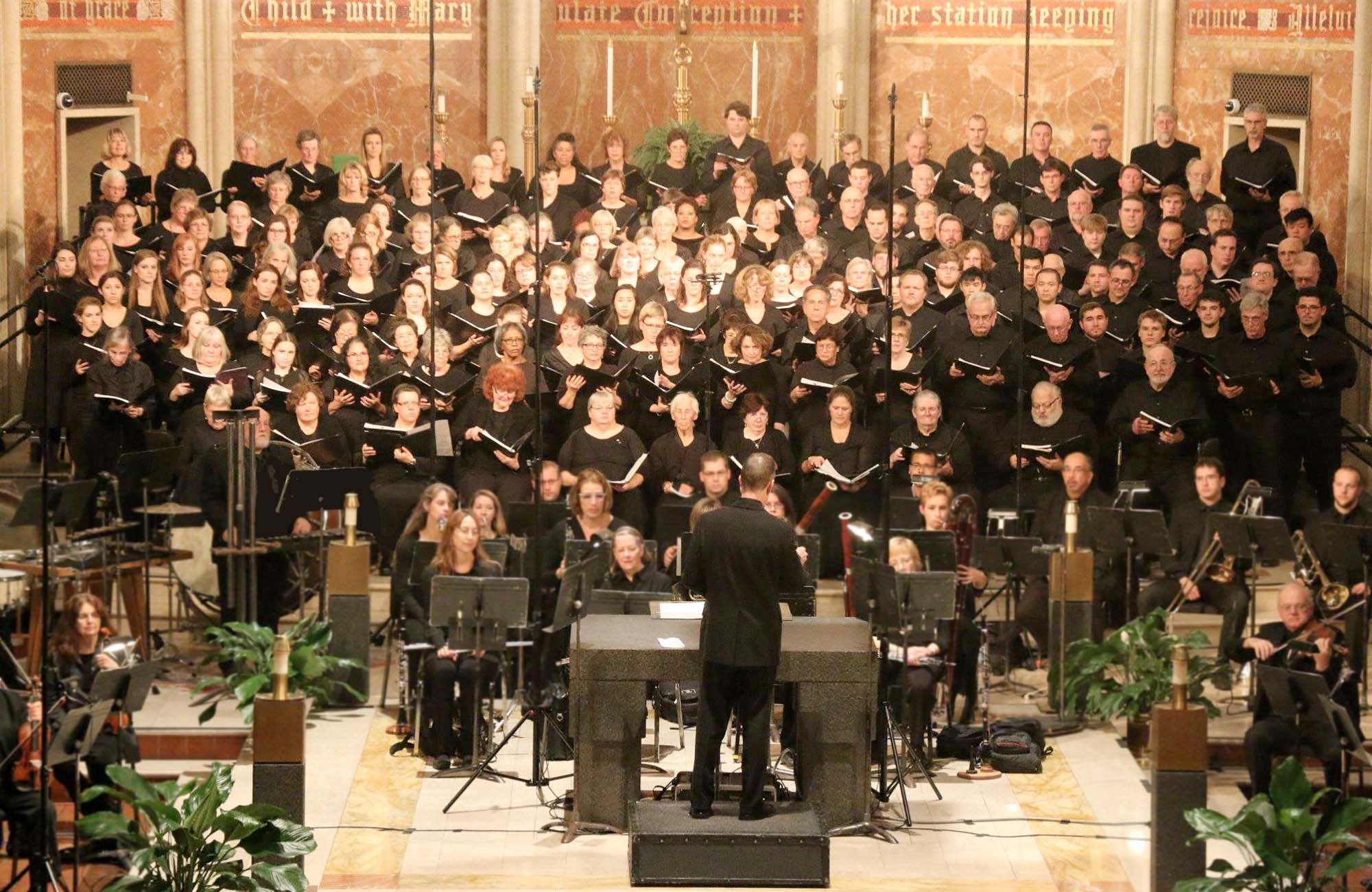
Founded in 1975, the Syracuse University Oratorio Society is a large chorus comprised of Syracuse University students and community members that regularly performs choral-orchestral masterworks with the Syracuse Orchestra. The Oratorio Society is directed by Dr. Wendy Moy.
Founded in 1975, the Syracuse University Oratorio Society is a large chorus comprised of Syracuse University students and community members that regularly performs choral-orchestral masterworks with the Syracuse Orchestra. The Oratorio Society is directed by Dr. Wendy Moy.


